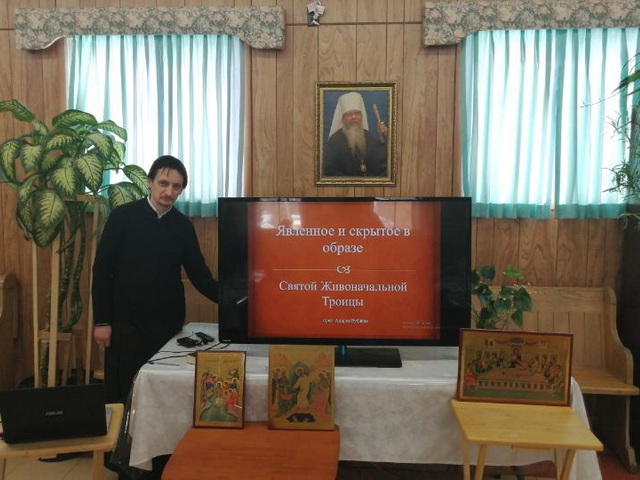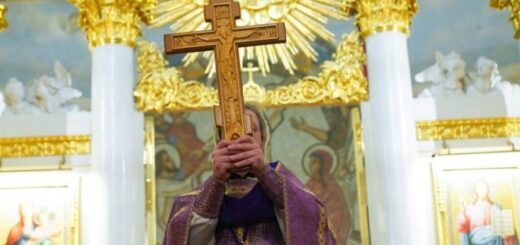Conference “The Revealed and Hidden in the Icon of the Holy Life-Giving Trinity by St. Andrei Rublev”

On February 9, our church hosted a conference on the icon of the Holy Life-Giving Trinity by St. Andrei Rublev. The conference was led by Deacon Denis, who gave an interesting account of the history of the icon and revealed the hidden meanings of the symbols depicted on the canvas of the famous artist.
The icon of the Holy Trinity by St. Andrei Rublev can hardly be called an icon in the literal sense of the word, since it depicts not hypostases (personalities), but the unity of the Holy Trinity [1].
Neither God the Father nor God the Holy Spirit became human, so they cannot be depicted in human form. What is depicted here? This icon can be said to be a prototype (τύπος – Greek) of the Holy Trinity, but in no way an illustration of the triune Deity.
The Church has forbidden the inscription (identification) of Angels, thus suppressing any attempt to indicate who is who.
The plot of this image is based on Abraham’s hospitality, described in the 18th chapter of the Book of Genesis. The forefather meets God himself, who appears to him in the form of three travelers (angels), which we learn from the further context (Gen. 19: 1).
Compositionally, the angels on the icon are arranged in the form of a circle – a symbol of eternity. The circle, in turn, is inscribed in the rectangular plane of the physical world, which in iconographic language is understood as the Epiphany. The Trinity is, as it were, in the center of the universe, and the center of the Trinity is the Chalice. The Old Testament sacrifice becomes a prototype of the Golgotha sacrifice of Christ, without which the salvation of the human race is impossible.
The salvation (dispensation) of God is also reminded of by Abraham’s tent behind the Angel on the left, and the mountain (the highest, “heavenly” meaning of what is happening) behind the Angel on the right, and the tree, which is the central element. If you draw a straight line, the tree will connect with the middle Angel and the Chalice.
Historically, the tree represents the Oak of Mamre, where the Lord met Abraham. God promised the forefather to restore the lost communion with God in Paradise (the salvation of man) through the fact that from him, Abraham, the Savior Christ would come.
Therefore, the tree stands in the middle – between the past (the tree of Life and the tree of the knowledge of good and evil) and the future (the Calvary Cross of Christ).
Thus, the image of the Holy Trinity speaks of divine love, trinity and sacrifice. From the historical plot, Reverend Andrew moves on to contemplation of the mystery of the inexpressible and indescribable triune God.
After the end of the conference, our parishioners did not want to let the lecturer go, asking him many questions.
On behalf of our entire parish, we thank Deacon Dionysius for a fascinating conference and hope that such events will become a good tradition in our parish.
________________________________________



